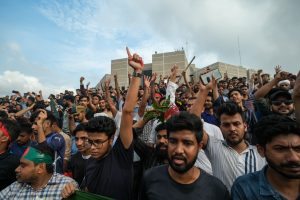Prime Minister Sheikh Hasina’s departure on August 5, following a 15-plus-year rule marked by increasing authoritarianism, signaled the culmination of a student-led revolution that upended the status quo in Bangladesh. The revolution, driven by the younger generation, emerged as a powerful force against the deep-seated authoritarianism that had taken root under Hasina’s regime. Several key factors contributed to the movement’s success and the eventual end of her rule.
One of the cornerstones of Hasina’s authoritarian grip was the near-deification of her family. The regime cultivated a narrative that sanctified not only Sheikh Hasina herself but also her father, Sheikh Mujibur Rahman, one of the founding leaders of Bangladesh, and other family members. The state glorified her family, erecting thousands of statues and suppressing any form of dissent against them. Criticizing Hasina’s father was made a crime, with offenders facing up to 12 years in jail. Academics and intellectuals were imprisoned for merely questioning Hasina or her family’s legacy, and the country lived in fear of the repercussions for speaking out.
However, the students leading the revolution shattered this constructed sanctity. When Hasina referred to the students as “Razakars” (a term used for those who collaborated with the Pakistani army during the 1971 War of Independence), they responded with outrage. They demanded an apology, marking a pivotal moment when the Hasina family’s untouchable status was publicly challenged. This bold defiance shook the very foundations of Hasina’s rule, as the students’ actions signaled a rejection of the reverence that had insulated her from direct criticism.
Alongside the myth-making centered on Hasina’s family, her regime also made the War of Independence an inviolable subject. The regime portrayed the war as a closed chapter in history, discouraging research or open debate about it. The war became an instrument of political legitimacy for the regime, and no one was allowed to challenge or reinterpret the official narrative.
The students broke this taboo by calling themselves “Razakars,” a powerful and provocative act that directly attacked the regime’s manipulation of history. Their willingness to adopt this charged label – previously used to delegitimize dissent – undermined the regime’s monopolization of the war narrative. This bold challenge to one of Hasina’s key pillars of power provoked her government to respond with violent repression, leading to the deaths of over 1,000 students. The regime’s brutal crackdown only inflamed public anger and weakened its hold on power.
A key turning point in the revolution was the students’ collective rejection of the fear of death. The martyrdom of Abu Sayed, an unarmed student who was killed by security forces for standing up against them, galvanized the movement. His death served as a powerful symbol of resistance and sacrifice, inspiring others to continue the struggle despite the brutal response from the government. Sayed’s martyrdom emboldened the protesters, and the regime’s attempts to suppress the movement through violence only steeled their resolve. The students, now seeing themselves as fighting for a righteous cause, were willing to risk their lives for the revolution. A subculture of protesting Hasina’s authoritarian regime was instilled among youths.
For years, Hasina’s regime had maintained control through a sophisticated propaganda apparatus, manipulating public perception and controlling the narrative. However, during the 36 days of the student-led revolution, her propaganda machine began to crumble. Despite Hasina’s efforts to portray herself as a benevolent leader, visiting burned-down locations and shedding tears in front of cameras, the public rejected her theatrics. The scale of violence and the deaths of so many students exposed the regime’s true nature. The regime’s narrative was no longer convincing to a population that had witnessed its authoritarianism firsthand.
Another crucial factor in the revolution’s success was the participation of various professional groups, including teachers, lawyers, and cultural activists. These groups provided institutional legitimacy and safety to the movement, helping it to continue during days of curfews and state crackdowns. Their involvement broadened the scope of the revolution, transforming it from a student-led protest into a nationwide movement. The participation of these professionals, along with the general public, broke the final taboo surrounding Hasina’s regime, further eroding its power and credibility.
Last but not the least, media including social media also played a key role in this revolution. Apart from a few media houses, individual journalists had covered the revolution with positive vibes, which helped inspire the movement.
The student-led revolution that brought an end to Sheikh Hasina’s 15-year rule was not just a political movement but a social and cultural upheaval. By dismantling the regime’s sacrosanct narratives – of both the Hasina family and the War of Independence – students directly challenged the foundation of her authoritarianism. Their willingness to sacrifice, combined with the failure of state propaganda and the solidarity of professional groups, culminated in the collapse of a regime that had once seemed untouchable. August 5 marked the end of an era, as Hasina’s resignation and departure symbolized the triumph of a new generation that refused to live under fear and repression.

































